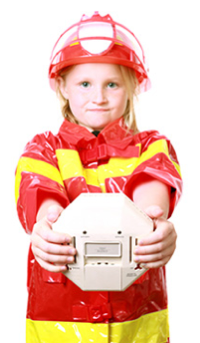National Burn Awareness Week 2018: Fires and burns are the 5th leading cause of injury-related death to children in the Unites States
Sharing is caring!

Did you know?
- As of 2016, there were a total of 285/100,000 deaths in the U.S. in children aged 0-19
- 44% of children who died from fires or burns were ages 4 and under.1 The death rate for children this age (0.73 per 100,000) is almost twice that of 5 to 9 year olds (0.42 per 100,000), and almost four times that of 10 to 14 year olds (0.23 per 100,000).
- While the death rate from fires and burns has decreased by 53% from 1999 to 2013, the number of deaths from fires and burns among children 19 and under increased 30% from 2012 to 2013.
- 126,035 children ages 19 and under were seen in emergency rooms for fire and burn injuries in 2013.
Prevention is Key: Tips for Fire and Burn Prevention
Working smoke alarms reduce the chance of dying in a reported home fire by half.
- Be “alarmed”
Install and maintain smoke alarms in your home –on every floor and near all rooms family members sleep in. Test your smoke alarms once a month to make sure they are working properly, and use long life batteries when possible. - Have an escape plan
Create and practice a family fire escape plan, and involve children in the planning. Make sure everyone knows at least two ways out of every room in the house, and identify a central meeting point outside in case of a fire. - Cook with care
Use safe cooking practices, such as never leaving food unattended on the stove. In addition, supervise or restrict children’s use of stoves, ovens, and especially microwaves (because they don’t know what can and cannot go in them). - Check water heater temperature
Set your water heater’s thermostat to 120°F or lower. Infants and small children may not be able to get away from water that may be too hot for them. So, maintaining a constant thermostat setting can help to control the water temperature throughout your home –preventing it from getting too high, and too hot.

References:
- https://www.cdc.gov/safechild/burns/index.html
- Centers for Disease Control and Prevention. WISQARS Cost of Injury Reports. Estimated number of nonfatal injuries and average and total lifetime costs. Nonfatal hospitalized injuries, both sexes, ages 0 to 19, United States, 2005. Intent: unintentional. Mechanism: Fire/burn. Available at http://wisqars.cdc.gov:8080/costT/. Accessed November 3, 2014
Also from: https://www.safekids.org/sites/default/files/documents/skw_burns_fact_sheet_feb_2015.pdf
Tagged with: National Burn Awareness Week 2018
Join us on Facebook


